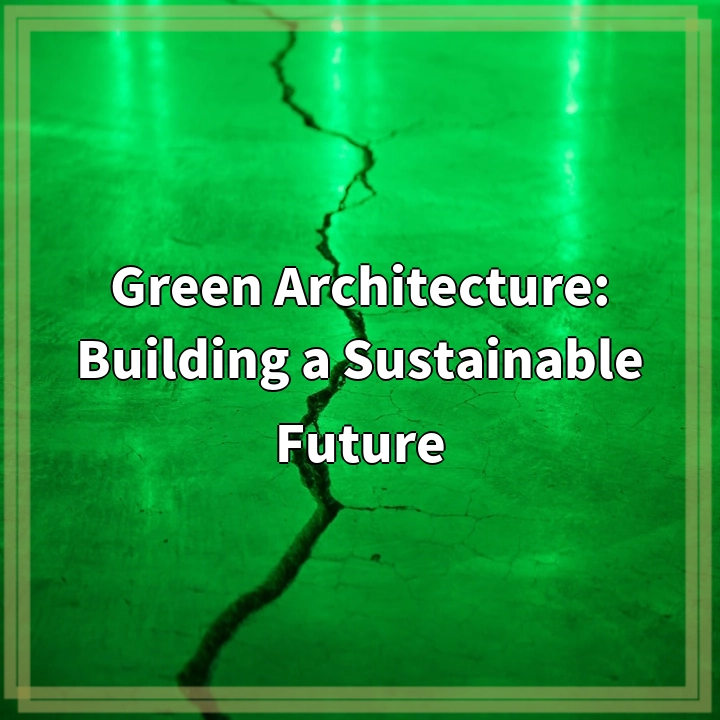Physical Address
304 North Cardinal St.
Dorchester Center, MA 02124
Physical Address
304 North Cardinal St.
Dorchester Center, MA 02124

Green architecture, also known as sustainable architecture or eco-friendly architecture, is an approach to design and construction that prioritizes the use of sustainable materials and practices. It aims to minimize the negative environmental impact of buildings while also promoting energy efficiency, reduced waste, and improved indoor air quality.
1. Limited Awareness
One of the main challenges of green architecture is the lack of awareness among both professionals and the general public. Many people are not fully aware of the benefits or the specific methods used in sustainable building practices.
2. Cost and Affordability
The cost of sustainable materials and technologies can be higher compared to traditional construction methods. This can pose a challenge for some developers and homeowners, potentially resulting in a reluctance to invest in sustainable architecture.
3. Limited Availability of Materials
Some sustainable building materials, such as bamboo or recycled materials, may not be readily available in all areas. This poses a challenge when it comes to sourcing materials locally and supporting the use of renewable resources.
4. Design and Aesthetic Considerations
Architects and designers often face challenges in incorporating sustainable elements into their designs while adhering to aesthetic preferences and client expectations. Striking a balance between functionality, sustainability, and visual appeal can be a complex task.
5. Technical Expertise
Implementing green architecture requires specialized technical knowledge and expertise. Architects, engineers, and builders need to stay updated on the latest sustainable practices, building codes, and emerging technologies to ensure the successful implementation of sustainable design principles.
6. Policy and Regulation
In some cases, inadequate or inconsistent policies and regulations related to green building practices can hinder the widespread adoption of sustainable architecture. Governments and regulatory bodies play a key role in incentivizing and enforcing green building standards.
1. Awareness and Education
Increasing awareness about the benefits of green architecture through public campaigns, workshops, and educational programs can help overcome the limited awareness challenge. Promoting the importance of sustainable practices and sharing success stories can inspire more people to adopt eco-friendly building methods.
2. Financial Incentives and Support
To address the cost and affordability challenge, governments can provide financial incentives and support for green building projects. This can include tax benefits, grants, or low-interest loans for sustainable construction. Such incentives can encourage developers and homeowners to invest in eco-friendly architecture.
3. Research and Development
Investing in research and development of sustainable building materials and technologies can help expand the availability and affordability of green materials. This can include the development of innovative alternatives to traditional construction materials, as well as advancements in renewable energy systems and smart building technologies.
4. Collaboration and Knowledge Sharing
Architects, engineers, and builders need to collaborate and share knowledge and best practices to improve technical expertise. Professional associations and industry forums can facilitate such collaborations and provide opportunities for continuous learning and skills development in the field of green architecture.
5. Policy Support and Regulation
Governments and regulatory bodies play a crucial role in supporting green architecture through the establishment and enforcement of building codes and standards that prioritize sustainability. Clear and consistent policies can create a conducive environment for the widespread adoption of eco-friendly building practices.
By addressing these solutions, we can overcome the real-world challenges associated with green architecture and pave the way for a more sustainable future. Increased awareness, financial incentives, research and development, collaboration, and effective policies are key in driving the adoption of eco-friendly building practices and building a greener, healthier, and more sustainable world.
Green architecture principles prioritize the use of sustainable materials and practices to minimize the negative environmental impact of buildings. By promoting energy efficiency, reducing waste, and improving indoor air quality, green architecture aims to create a more sustainable future. Challenges such as limited awareness, cost considerations, and technical expertise can be overcome through increased education, policy support, and innovation. By prioritizing sustainable design principles, we can build a more environmentally friendly future while creating healthier and more efficient living spaces.
Green architecture holds tremendous potential in addressing the environmental challenges we face today. While there are real-world problems associated with its implementation, such as limited awareness, cost considerations, and technical expertise, these challenges can be overcome through increased education, policy support, and innovation. By prioritizing sustainable design principles, we can build a more environmentally friendly future while creating healthier and more efficient living spaces.
Green architecture principles prioritize the use of sustainable materials and practices to minimize the negative environmental impact of buildings. By promoting energy efficiency, reducing waste, and improving indoor air quality, green architecture aims to create a more sustainable future. Challenges such as limited awareness, cost considerations, and technical expertise can be overcome through increased education, policy support, and innovation. By prioritizing sustainable design principles, we can build a more environmentally friendly future while creating healthier and more efficient living spaces.
Green architecture holds tremendous potential in addressing the environmental challenges we face today. While there are real-world problems associated with its implementation, such as limited awareness, cost considerations, and technical expertise, these challenges can be overcome through increased education, policy support, and innovation. By prioritizing sustainable design principles, we can build a more environmentally friendly future while creating healthier and more efficient living spaces.
If you’re wondering where the article came from!
#